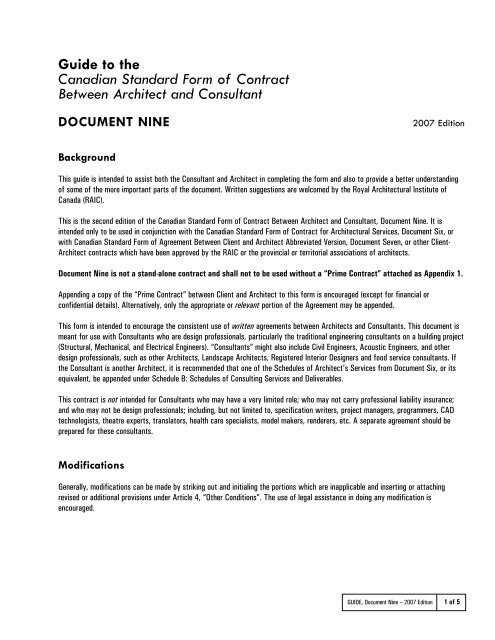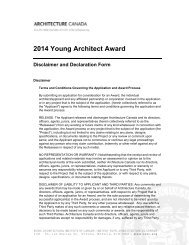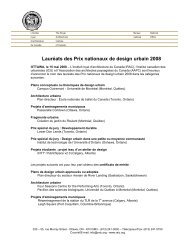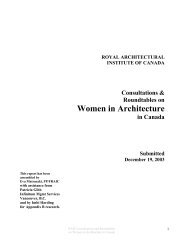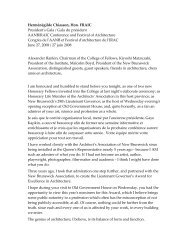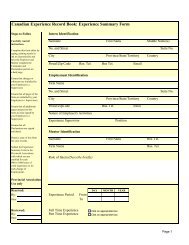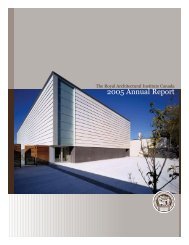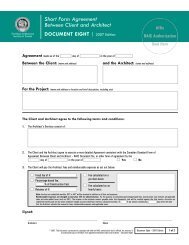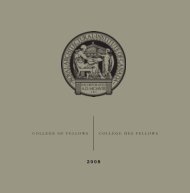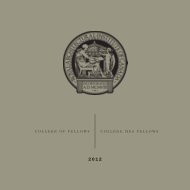Guide - Document 9 - Royal Architectural Institute of Canada
Guide - Document 9 - Royal Architectural Institute of Canada
Guide - Document 9 - Royal Architectural Institute of Canada
Create successful ePaper yourself
Turn your PDF publications into a flip-book with our unique Google optimized e-Paper software.
<strong>Guide</strong> to the<br />
Canadian Standard Form <strong>of</strong> Contract<br />
Between Architect and Consultant<br />
DOCUMENT NINE<br />
2007 Edition<br />
Background<br />
This guide is intended to assist both the Consultant and Architect in completing the form and also to provide a better understanding<br />
<strong>of</strong> some <strong>of</strong> the more important parts <strong>of</strong> the document. Written suggestions are welcomed by the <strong>Royal</strong> <strong>Architectural</strong> <strong>Institute</strong> <strong>of</strong><br />
<strong>Canada</strong> (RAIC).<br />
This is the second edition <strong>of</strong> the Canadian Standard Form <strong>of</strong> Contract Between Architect and Consultant, <strong>Document</strong> Nine. It is<br />
intended only to be used in conjunction with the Canadian Standard Form <strong>of</strong> Contract for <strong>Architectural</strong> Services, <strong>Document</strong> Six, or<br />
with Canadian Standard Form <strong>of</strong> Agreement Between Client and Architect Abbreviated Version, <strong>Document</strong> Seven, or other Client-<br />
Architect contracts which have been approved by the RAIC or the provincial or territorial associations <strong>of</strong> architects.<br />
<strong>Document</strong> Nine is not a stand-alone contract and shall not to be used without a “Prime Contract” attached as Appendix 1.<br />
Appending a copy <strong>of</strong> the “Prime Contract” between Client and Architect to this form is encouraged (except for financial or<br />
confidential details). Alternatively, only the appropriate or relevant portion <strong>of</strong> the Agreement may be appended.<br />
This form is intended to encourage the consistent use <strong>of</strong> written agreements between Architects and Consultants. This document is<br />
meant for use with Consultants who are design pr<strong>of</strong>essionals, particularly the traditional engineering consultants on a building project<br />
(Structural, Mechanical, and Electrical Engineers). “Consultants” might also include Civil Engineers, Acoustic Engineers, and other<br />
design pr<strong>of</strong>essionals, such as other Architects, Landscape Architects, Registered Interior Designers and food service consultants. If<br />
the Consultant is another Architect, it is recommended that one <strong>of</strong> the Schedules <strong>of</strong> Architect’s Services from <strong>Document</strong> Six, or its<br />
equivalent, be appended under Schedule B: Schedules <strong>of</strong> Consulting Services and Deliverables.<br />
This contract is not intended for Consultants who may have a very limited role; who may not carry pr<strong>of</strong>essional liability insurance;<br />
and who may not be design pr<strong>of</strong>essionals; including, but not limited to, specification writers, project managers, programmers, CAD<br />
technologists, theatre experts, translators, health care specialists, model makers, renderers, etc. A separate agreement should be<br />
prepared for these consultants.<br />
Modifications<br />
Generally, modifications can be made by striking out and initialing the portions which are inapplicable and inserting or attaching<br />
revised or additional provisions under Article 4, “Other Conditions”. The use <strong>of</strong> legal assistance in doing any modification is<br />
encouraged.<br />
GUIDE, <strong>Document</strong> Nine – 2007 Edition 1 <strong>of</strong> 5
Definitions<br />
It is intended that all definitions and all terms which are used in the Prime or “Parent” Contract carry the same meaning when used in<br />
<strong>Document</strong> Nine. Because <strong>Document</strong> Nine is intended to be used with any form <strong>of</strong> Client-Architect Contract, defined terms are not<br />
highlighted in italics nor capitalized as they are in Canadian Standard Form <strong>of</strong> Contract for <strong>Architectural</strong> Services, <strong>Document</strong> Six or<br />
other RAIC contract documents.<br />
The term “Agreement” has been replaced by the term “Contract” to be consistent with <strong>Document</strong> Six.<br />
Consultant's Services<br />
The Consultant's Services are defined in Article 2.1 and may be better identified and listed by using one <strong>of</strong> the optional Schedules <strong>of</strong><br />
Consultant's Services and Deliverables and appending the selected Schedule as Schedule B.<br />
The optional Schedules could also be used checklists to assist the Architect and Consultant in identifying the required services and<br />
negotiating an appropriate contract. Alternatively the Architect may wish to reference another document. For example:<br />
Provide services as set out in the <strong>Guide</strong>line from the Pr<strong>of</strong>essional Engineers <strong>of</strong> Ontario (PEO): Pr<strong>of</strong>essional Engineers Providing<br />
Mechanical and Electrical Engineering Services in Buildings (1997) Article 2 “Basic mechanical and electrical engineering services”.<br />
These services must be compatible with those services the Client and Architect have agreed are necessary for the implementation <strong>of</strong><br />
the project. The Contract between Architect and Client will define the degree <strong>of</strong> the Consultant's involvement so that input and time<br />
can be estimated and the fee arrangements determined.<br />
Ensure that all Consultants understand the full extent and terminology <strong>of</strong> services required under Construction Phase – Contract<br />
Administration <strong>of</strong> the Prime Contract. For example, “Contract Administration” includes more pr<strong>of</strong>essional services than the term “Field<br />
Review” as defined by the Association <strong>of</strong> Canadian Engineering Companies (ACEC) and therefore there must be agreement on the<br />
extent <strong>of</strong> services provided by the Consultant during the Construction Phase including certification as per the Prime Contract.<br />
The Consultant's monthly review <strong>of</strong> the Work for percentage and value for this part <strong>of</strong> the project must be completed and submitted<br />
to the Architect to allow sufficient time for the Architect to submit the monthly Certificates as required.<br />
General Conditions<br />
Article 2.1.1<br />
The role <strong>of</strong> the Architect must be reviewed with the Consultant as well as the services required <strong>of</strong> the Consultant for General Review<br />
/ Field Review and in assisting the Architect in issuing Certificates for Payment.<br />
Article 2.1.4<br />
At the outset <strong>of</strong> the project, there must be a mutual agreement between the Architect and Consultant with respect to the number <strong>of</strong><br />
copies <strong>of</strong> all documents, and the frequency <strong>of</strong> submissions.<br />
Article 2.1.5<br />
(Refer to Article GC.3 <strong>of</strong> <strong>Document</strong> Six, Canadian Standard Form <strong>of</strong> Contract for <strong>Architectural</strong> Services or similar provisions in other<br />
approved contracts.)<br />
GUIDE, <strong>Document</strong> Nine – 2007 Edition 2 <strong>of</strong> 5
The Architect and the Consultant must clearly understand each others' responsibilities concerning the Construction Budget and the<br />
consulting services which are provided for This Part <strong>of</strong> the Project. In addition, Consultants must be aware <strong>of</strong> the provisions <strong>of</strong> Article<br />
GC.3, Construction Budget and Construction Costs, <strong>of</strong> <strong>Document</strong> Six.<br />
Article 2.2.2<br />
The standard Prime Contracts such as <strong>Document</strong>s Six and Seven, stipulate payment provisions: <strong>Document</strong> Six and <strong>Document</strong> Seven<br />
require payment when invoices are rendered. Both documents provide for interest on unpaid accounts commencing as described in<br />
Article A15 <strong>of</strong> the Agreement Form in <strong>Document</strong> Six and Article 4.9 <strong>of</strong> <strong>Document</strong> Seven.<br />
If the terms <strong>of</strong> payment differ from the Prime Contract, then the specific terms and conditions must be negotiated with the<br />
Consultant and set out under Schedule A, Article A4, Payment Provisions.<br />
Article 3.1<br />
This article requires that the Consultant maintain pr<strong>of</strong>essional liability insurance, as required under the Prime Agreement. It is good<br />
practice to obtain a certificate or pro<strong>of</strong> <strong>of</strong> insurance for your records and append it under Appendix 2.<br />
Dispute Resolution<br />
The article that previously referenced CCDC 40, Rules <strong>of</strong> Mediation and Arbitration <strong>of</strong> Construction Disputes, has been deleted to be<br />
in keeping with <strong>Document</strong> Six which has been amended to remove references to CCDC 40. The Dispute Resolution provisions <strong>of</strong> the<br />
Prime Agreement should be applied.<br />
Termination and Suspension<br />
It is intended that all terms and conditions related to Termination and Suspension which are used in the Prime or “Parent” Contract<br />
apply to the Consultant. For this reason, there is no General Condition regarding Suspension <strong>of</strong> the project; however, in the event <strong>of</strong><br />
non-performance <strong>of</strong> the Consultant, the Architect may invoke General Condition 3.2. In the event that neither <strong>Document</strong> Six or Seven<br />
are used, the Architect should ensure that the Prime Contract has appropriate terms and conditions for Termination and Suspension.<br />
Completing the Contract Form<br />
Date: The date represents the date <strong>of</strong> entry into Contract. It may be the date <strong>of</strong> submission to the Consultant (after authorization<br />
from the Client), or the date <strong>of</strong> actual execution. No pr<strong>of</strong>essional services under this Contract should be performed prior to the date<br />
indicated.<br />
Identification <strong>of</strong> Parties to the Contract: Parties to this Contract should be identified in the capacity in which the Contract is<br />
executed, including the name <strong>of</strong> the firms and capacity <strong>of</strong> persons signing, the address <strong>of</strong> principal <strong>of</strong>fice, a designation <strong>of</strong> the legal<br />
status <strong>of</strong> both parties (e.g. sole proprietor, partnership, joint venture, limited partnership or corporation, etc.), and the discipline <strong>of</strong> the<br />
Consultant.<br />
Date: The second entry for a date is the exact date which appears on the Prime Contract.<br />
Project Description: This description should duplicate identically the description <strong>of</strong> the project in the Prime Contract.<br />
Pr<strong>of</strong>essional Services: Describe the type and scope <strong>of</strong> the services included in this Contract. Furthermore, it is recommended that a<br />
Schedule <strong>of</strong> Consultant's Services and Deliverables be prepared and appended to this Contract as Schedule B.<br />
GUIDE, <strong>Document</strong> Nine – 2007 Edition 3 <strong>of</strong> 5
Other Conditions<br />
(refer also to “Schedules <strong>of</strong> Services” in Canadian Standard Form <strong>of</strong> Contract for <strong>Architectural</strong> Services, <strong>Document</strong> Six)<br />
Clearly describe additional requirements to the agreement in this Section. Legal assistance is encouraged in drafting Other Conditions<br />
or requirements to this Contract.<br />
Some additional provisions could include:<br />
• Additional phases such as pre-design, site analysis, or post-construction, and the services provided for each;<br />
• Additional services, and fee arrangements for them;<br />
• Special sub-consultants as provided in the Consultant's services;<br />
• Requirements for attending meetings with Client and others;<br />
• Requirements for scheduling and approvals;<br />
• Preparation <strong>of</strong> multiple sets <strong>of</strong> Construction <strong>Document</strong>s for separate contracts;<br />
• Construction Delivery method;<br />
• Limits to Construction Cost or Time <strong>of</strong> performance;<br />
• Extensive or continuous site representation;<br />
• Submission <strong>of</strong> invoices, accounting procedures and formats and payments to Consultant;<br />
• Modifications to any service.<br />
Schedule A – Fees and Reimbursable Expenses<br />
Article A1.1<br />
The method <strong>of</strong> calculating fees and expenses must be clearly defined. If the fee is to be:<br />
a) Hourly rates: List all applicable rates for all personnel including principals;<br />
b) Multiple <strong>of</strong> Direct Personnel Expense: Fees and services shall be based on a multiple <strong>of</strong> direct personnel expense as<br />
described in the Prime Contract and expenses shall be based on the Prime Contract (refer to Articles 4.2 and 4.3 <strong>of</strong> <strong>Document</strong><br />
Six). These articles should be referenced or inserted into this Section.<br />
c) Fixed Fee: Insert a sentence spelling out the fee as well as providing a numerical sum, such as<br />
Fees shall be a fixed fee <strong>of</strong> ______________ dollars ($ ).<br />
d) Percentage <strong>of</strong> Construction Cost: Insert the appropriate method <strong>of</strong> construction contract and the percent:<br />
Fees shall be based on one <strong>of</strong> the following percentages <strong>of</strong> Construction Cost.<br />
For the portion <strong>of</strong> the project to be awarded under:<br />
A single, stipulated sum construction contract: _________________ percent ( %)<br />
Separate, stipulated sum construction contracts: _________________ percent ( %)<br />
GUIDE, <strong>Document</strong> Nine – 2007 Edition 4 <strong>of</strong> 5
A single, cost-plus construction contract: _________________ percent ( %)<br />
Separate, cost-plus construction contracts: _________________ percent ( %)<br />
If applicable, insert the percentages <strong>of</strong> the fees payable for each separate phase <strong>of</strong> services. For example:<br />
Schematic Design Phase: Twelve and one half percent (12.5%)<br />
Design Development Phase: Twelve and one half percent (12.5%)<br />
Construction <strong>Document</strong>s Phase: Fifty Percent (50%)<br />
Bidding and Negotiating Phase: Five percent (5%)<br />
Construction Phase: Twenty Percent (20%)<br />
Total: One hundred percent (100%)<br />
Refer also to the provincial or territorial tariff or schedules <strong>of</strong> fees for services, if applicable .<br />
Article A2.1<br />
Fees for additional services should be clearly defined as described above for Hourly Rates or Direct Personnel Expense.<br />
Lien Legislation<br />
Payment provisions should be reviewed with the lien legislation applicable in the Place <strong>of</strong> the Work as holdbacks for pr<strong>of</strong>essionals are<br />
required in some jurisdictions. (the referenced provisions are not applicable in British Columbia)<br />
Schedule B – Schedule <strong>of</strong> Consultant's Services and Deliverables<br />
Prepare and append a Schedule <strong>of</strong> Consultant's Services and Deliverables<br />
Appendix 1 – Prime Contract<br />
Append a copy <strong>of</strong> the “Prime Contract” between Client and Architect to this form (except for financial or confidential details).<br />
Alternatively, only the relevant portion <strong>of</strong> the Contract may be appended, including Schedules <strong>of</strong> Services and Client Responsibilities.<br />
Appendix 2 – Pr<strong>of</strong>essional Liability Insurance<br />
Append a copy <strong>of</strong> the Consultant's Certificate <strong>of</strong> Insurance<br />
GUIDE, <strong>Document</strong> Nine – 2007 Edition 5 <strong>of</strong> 5


